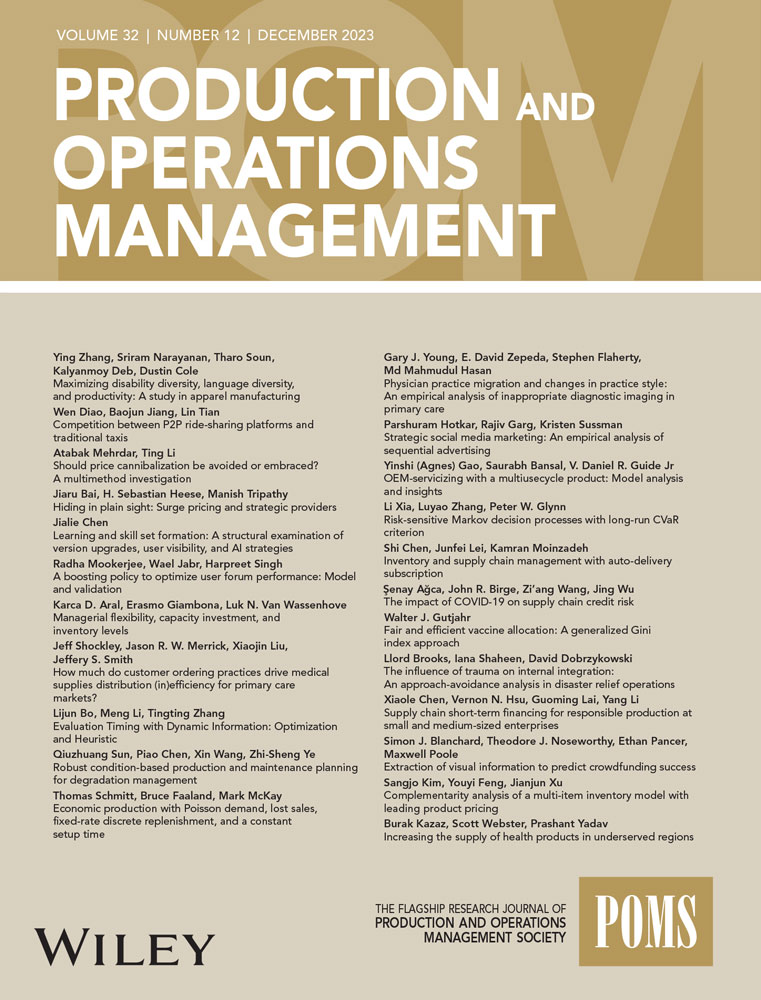多项logit选择模型下的陈列优化:收益与顾客满意度的平衡
IF 5.1
3区 管理学
Q1 ENGINEERING, MANUFACTURING
引用次数: 0
摘要
在本文中,我们考虑了一个分类优化问题,其中平台必须在一系列T阶段中选择成对不相交的分类集。到达的顾客在第一阶段开始他们的搜索过程,然后依次进行,直到他们的耐心耗尽,这时他们从他们在搜索过程中看到的所有产品中做出基于多项逻辑的购买决策。目标是选择产品的顺序显示,以最大限度地提高预期收入。此外,我们施加了特定于阶段的约束,以确保随着每个客户在T阶段中的进展越来越远,所展示的产品集合满足了最低程度的“可取性”。我们考虑了两种相关的可取性度量:购买可能性和期望效用,从提供的分类中得到。通过这种方式,提供的分类序列必须既高收入又受欢迎,这打破了传统的分类设置,在传统的分类设置中,以客户为中心的考虑通常没有明确考虑。我们表明,我们感兴趣的分类问题是强NP-Hard的,因此排除了一个完全多项式时间近似方案(FPTAS)的存在。从算法的角度来看,作为热身,我们开发了一个简单的常数因子近似方案,在这个方案中,我们仔细地将每个阶段近视选择的分类拼接在一起。我们的主要算法结果由一个多项式时间近似方案(PTAS)组成,该方案结合了一些与近似动态规划框架内最优分类序列组成相关的结构结果。我们还提供了一个额外的近似方案,在温和的假设下,它可以处理基数约束,强制在每个阶段引入精确数量的新产品。通过大量的数值实验,我们证明了这两种算法都表现出出色的实际性能,产生的分类序列平均总是在最优的2%以内。本文章由计算机程序翻译,如有差异,请以英文原文为准。
Display optimization under the multinomial logit choice model: Balancing revenue and customer satisfaction
In this paper, we consider an assortment optimization problem in which a platform must choose pairwise disjoint sets of assortments to offer across a series of T stages. Arriving customers begin their search process in the first stage, and progress sequentially through the stages until their patience expires, at which point they make a multinomial logit–based purchasing decision from among all products they have viewed throughout their search process. The goal is to choose the sequential displays of product offerings to maximize expected revenue. Additionally, we impose stage-specific constraints that ensure that as each customer progresses farther and farther through the T stages, there is a minimum level of “desirability” met by the collections of displayed products. We consider two related measures of desirability: purchase likelihood and expected utility derived from the offered assortments. In this way, the offered sequence of assortments must be both high earning and well liked, which breaks from the traditional assortment setting, where customer-centric considerations are generally not explicitly accounted for. We show that our assortment problem of interest is strongly NP-Hard, thus ruling out the existence of a fully polynomial-time approximation scheme (FPTAS). From an algorithmic standpoint, as a warm-up, we develop a simple constant factor approximation scheme in which we carefully stitch together myopically selected assortments for each stage. Our main algorithmic result consists of a polynomial-time approximation scheme (PTAS), which combines a handful of structural results related to the make-up of the optimal assortment sequence within an approximate dynamic programming framework. We also provide an additional approximation scheme, which, under mild assumptions, can handle a cardinality constraint that enforces that an exact number of new products are introduced at each stage. Using an extensive set of numerical experiments, we demonstrate that both algorithms exhibit excellent practical performance, producing sequences of assortments that are, on average, always within 2% of optimal.
求助全文
通过发布文献求助,成功后即可免费获取论文全文。
去求助
来源期刊

Production and Operations Management
管理科学-工程:制造
CiteScore
7.50
自引率
16.00%
发文量
278
审稿时长
24 months
期刊介绍:
The mission of Production and Operations Management is to serve as the flagship research journal in operations management in manufacturing and services. The journal publishes scientific research into the problems, interest, and concerns of managers who manage product and process design, operations, and supply chains. It covers all topics in product and process design, operations, and supply chain management and welcomes papers using any research paradigm.
 求助内容:
求助内容: 应助结果提醒方式:
应助结果提醒方式:


